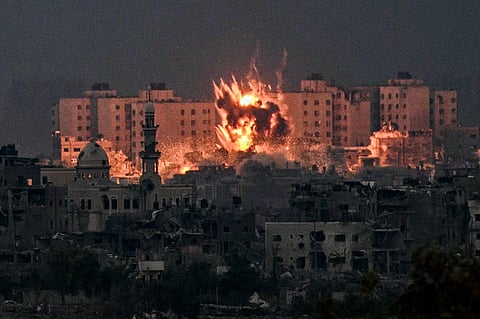

It is a war out of the blue. The failure of the famed Israeli surveillance machinery to detect the scale of the Hamas attack; and now the overwhelming return fire from Tel Aviv has the world reeling. Israel is looking for revenge. There is a huge humanitarian crisis in the Gaza strip. Palestinian casualties from starvation; and lack of medical aid will be higher than those killed from bombs and guns.
Both sides are counting their dead. There is a hostage crisis; and the blockade and bombing is flattening what is left of the Gaza stip. The world is on edge as a new war zone threatens to envelop the region. Quite suddenly the focus has shifted from Russia’s Ukraine war. The new Gaza outbreak is an unfortunate reminder that the world is at a new nadir since World War II.
A recent survey by wisevoter.com showed 32 countries across the globe at war with another, or in a state of armed conflict internally with civil wars, and ethnic conflict. The collective human and economic costs are mind-boggling. Militarization is on the rise and the international language has become more divisive, more aggressive.
Growing conflict zones
Sample the costs: The Ukraine war has left nearly 500,000 troops either dead or injured, according to the New York Times. As many as 120,000 Russian troops have been killed and 180,000 injured, with Ukraine’s military toll at 70,000 killed and up to 20,000 wounded. The incessant missile attacks on Ukraine have turned over 6 million of the country’s 41 million people into refugees across Europe. The war has created a slump that has wiped out $1.6 trillion off the international economy, a study by the German Institute of Economic Affairs has estimated.
Let’s take a peek into some of the other conflict zones that don’t hog the headlines. Christian Armenia and Islamic Azerbaijan in the south Caucasus have been at war over territory and ethnic issues for over two decades. More than 7,000 soldiers have been killed on either side since the new conflagration broke out in 2020. At the centreof the dispute has been the ethnic Armenian enclave of Nagorno-Karabakh in Azerbaijan. In the most recent hostilities, Azerbaijan got the military upper hand and almost the entire 150,000 Armenians have fled to Armenia creating a huge refugee crisis.
One of 2022’s deadliest wars has been fought in Ethiopia between the breakaway region’s Tigray People’s Liberation Front (TPLF) and the Ethiopian government led by Prime Minister Abiy Ahmed. Hostilities started in 2020, with the advantage shifting back and forth; but if there is a region that has seen death and destruction of civilians, and sexual violence of horrendous proportions, it is Tigray. Researchers in Belgium’s Ghent University estimate that 385,000 to 600,000 civilians had died of war-related causes as of August 2022.
Interstate wars are of different intensities. There are the simmering kinds that run through decades with occasional outbreak of hostilities like our wars with Pakistan since 1947, and hostilities over the undefined sections of India’s long 3,500 km border with China since 1962.
But what has become more prominent in recent years is intense civil wars, especially in many African countries where large chunks of the country as in Nigeria, Central African Republic and Niger have been taken hold by Islamic factions or ethnic groups. In Asia, ultra nationalism as a panacea to economic distress has triggered its own aggressive militarism. China under Premier Xi Jinping is pushing for a forced merger of Taiwan with China, and the Myanmar military junta has been evicting non-Buddhist minorities like the Muslim Rohingyas.
The war industry
While economies and lives waste away, the symbiotic relationship between the growing militarisation and the improving health of the corporate arms manufacturers is difficult to miss. Sales of arms and military services by the world’s 100 biggest defence companies has risen consecutively for 7 years. Despite the Covid pandemic and supply chain issues that have held up shipment of critical components, calendar 2021 saw a rise of 1.9% in arms sales touching a humungous $592 billion, according to data from the Stockholm International Peace Research Institute (SIPRI).
It’s not difficult to track where the money is going: Of the top 8 arms manufacturers, 5 are US corporates. Their 2021 sales figures: Lockheed Martin ($61 billion), Raytheon ($41 bn), Boeing ($33 bn), Northrop Grumman ($30 bn) and General Dynamics ($26 bn).
The Watson Institute, Brown University, US has computed the possible cost of US’ failed intervention since9/11 in Afghanistan, Pakistan, Iraq, Syria, Yemen, etc – countries that faced the backlash of the New York bombings in 2001.Direct deaths: 905,000-940,000;indirect deaths in the war zones: 3.6-3.8 million; People displaced: 38 million;US’ budgetary costs: $8 trillion which includes ‘counter-terrorism’ operations in 85 countries.
As we write this, the Israel army has massed tanks on the Gaza border and ordered 1.1 million Palestinians in the North to move South in 24 hours. This will create a ghetto of refugees easier to administer, Israel hopes, in a 140 km strip, already the most dense pocket of humanity anywhere in the world. Doesn’t look like peace has a scrap of a chance.